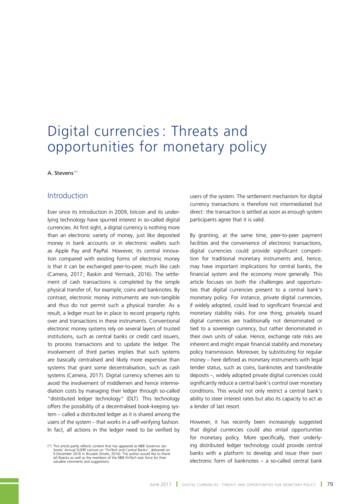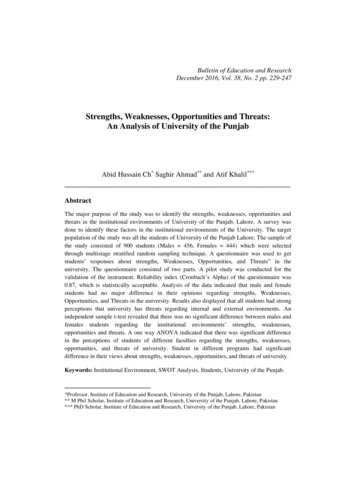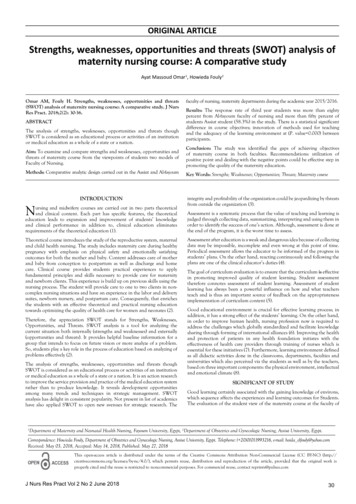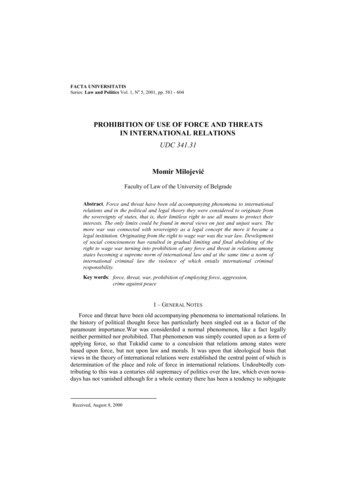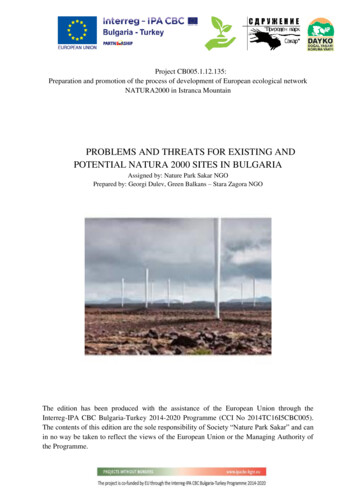
Transcription
Project CB005.1.12.135:Preparation and promotion of the process of development of European ecological networkNATURA2000 in Istranca MountainPROBLEMS AND THREATS FOR EXISTING ANDPOTENTIAL NATURA 2000 SITES IN BULGARIAAssigned by: Nature Park Sakar NGOPrepared by: Georgi Dulev, Green Balkans – Stara Zagora NGOThe edition has been produced with the assistance of the European Union through theInterreg-IPA CBC Bulgaria-Turkey 2014-2020 Programme (CCI No 2014TC16I5CBC005).The contents of this edition are the sole responsibility of Society “Nature Park Sakar” and canin no way be taken to reflect the views of the European Union or the Managing Authority ofthe Programme.
Bulgaria has established its NATURA 2000 National Ecological Network in theperiod 2003-2007. The Special Protected Areas (SPAs) - 119 – have been designated withminister of environment’s orders in 2007-2014. So far, most of the protected sites under theHabitats Directive (SCI) have not been degignated with orders (8 out of 233 were announcedin 2015-2016). While there are prohibitions and limitations on human activities in thedesignation orders (where existing), they are too general, superficial and are not based ondetailed studies on specific threats to the conservation objectives. This combined with the lackof Management Plans for most of the NATURA 2000 sites (only 8 MPs have been approved)and the lack of NATURA 2000 management bodies, allows both a misused interpretation ofnature conservation legislation in detriment to the conservation objectives and its apparentviolation without serious consequences for the offenders. In this report have beensystematized only a small part of the numerous threats to species and habitats in Natura 2000sites.The Kaliakra CaseIn the area of Cape Kaliakra and its closest coastal areas there are several N2000sites - Kaliakra BG0002051 SPA, Kompleks Kaliakra BG0000573 SCI, Belite SkaliBG0002097 SPA and Kraymorska Dobrudzha BG0000130 SCI. Here is the only place inBulgaria where remains of the Dobrudzha steppe are prserved (see Map 1 and Map 2 ofAppendix 1). Here are also the largest sea cliffs on the Bulgarian Black Sea coast. The area isinhabited by typical steppe bird species - Eurasian stone curlew (Burhinus oedicnemus),Greater Short-toed Lark (Calandrella brachydactyla) and Calandra lark (Melanocoryphacalandra), 4 species of Wheatears (Oenanthe), Rosy starling (Sturnus roseus). Kaliakra is ofcrucial importance for the survival of the first three species, because they have the highestnumbers for the country in this region. Almost the entire breeding population of the Piedwheatear (Oenanthe pleschanka) - 81% - is concentrated in the Kaliakra region. Rockyseashores are inhabited by the only colony of European shag (Phalacrocorax aristotelis) inour country. In the sea area of Kaliakra are registered the largest flocks of Mediterraneanshearwater in Bulgaria.The importance of the region during migration is extremely high, as it is located onone of the two most intense migratory flyways in Europe - Via Pontica. Over the Kaliakrathere are significant numbers of soaring birds every autumn - up to 200,000 storks, pelicansand cranes, as well as over 10,000 birds of prey, including the globally endangered Pallidharrier (Circus macrourus), Saker falcon (Falco cherrug) and Imperial Eagle (Aquilaheliaca). Due to Kaliakra's specific geographic location as well as due to constant winds,when the birds meet the sea on their way south, they stay longer in the area to overcome air
currents and to return overland, as well as to gain height. Over 60% of birds fly up to 150 mof height and thus fall directly within the range of the wind turbine blades. Due to the strongwinds migrating birds (mainly storks and harriers) land here to rest also in the day, and raptorsstay to feed. Stork flocks regularly roosr in the areas between Kavarna and Tyulenovo.Numerous flocks of migratory songbirds stop for rest and serch of food - Quail and globallythreatened Corn crake (Crex crex). These birds are mainly night-time migrants. Over 50,000songbirds are recorded during autumn migration only during the daylight. Significantnumbers of waterfowl spend the winter in Kaliakra region, mainly geese, which stay fromDecember to March. They spend the night in the sea and fly over the area daily to feed in theinshore fields. Coastal Dobrudzha is of primary international importance for the conservationof the Red-breasted goose (Branta ruficollis), as during the winter here concentrates almostentire of the world's population of the species.Ponto-sarmathian steppe, KaliakraPhoto:The authorBecause of the unique landscape, endangered habitats, plant and animal species,Cape Kaliakra, the rocky shores and their adjacent steppes and coastal waters are underprotection - the Cape is declared "Kaliakra" strict reserve, and part of the rocks and coastalsteppes - "Yailata" protected area. The Kaliakra area has been declared an Important BirdArea (IBA) because of its importance for birds. In 2007 a part of the Kaliakra IBA wasincluded in Natura 2000 as a bird protection site, and only in 2013 the entire territory of theIBA was included in Natura 2000. The coastal areas were designated as SCI "KaliakraComplex".
Rocky formations, Tyulenovo, KaliakraPhoto: The autorBy the end of 2014 a total of 482 projects had been registered in area, excludingthose who were declared to have lost validity by that date (a total of 15 projects). Twenty-sixof the projects are related to the construction of wind turbines. A total of 147 wind turbineshave already been built and 102 turbines operate, another 11 are under construction, 26 havebeen approved but not built and 8 are in an EIA procedure (see Map 3 of Appendix 1). Windfarms are approved in an area where there is a high risk for birds, without EIA or EIAprocedures, but based on incomplete reports of poor quality. The already operating windgenerators have led to the mortality of endangered bird species such as White pelican,Common crane, Eurasian eagle-owl, Griffon vulture, Common buzzard, and displased theRed-breasted goose from its feeding grounds in the Kaliakra region. It has also been shownthat wind turbines are the main reason for the loss of this species’ habitats in the CoastalDobrogea. They are also a barrier to bird migration - both raptors and waterfowl. The windfarms built in the steppes around the village of Bulgarevo have resulted in the destruction andsignificant deterioration of priority and strictly protected habitats - the Ponto-Sarmathiansteppes, with over 180 ha of affected area. Although the measures taken in 2012 to stop newwind turbine projects and limitation of decisions taken to approve wind turbines, ondocuments it is possible to build 45 wind turbines on the territory of the IBA and the KaliakraSPA, and over 200 wind turbines in the surrounding areas, which will further exacerbate theproblem of significant impact on birds and their habitats.
Wind farm, KaliakraPhoto: The author458 projects, other than wind turbines, fall entirely or partially in Kaliakra SPA. Allof them are approved with the judgment that no EIA is required. Some of them haveundergone Appropriate Assessment, but have been approved on the basis of incompletereports of poor quality. By the end of 2014, 11 projects were implemented, 3 of which are inthe agricultural sector (creation of orchards and irrigation of vineyards), 5 energy projectsrelated to the construction of wind farm infrastructure, 3 projects for resort development and 1aquaculture project in coastal marine waters. Realized projects cover 288.7 ha of land. Someof these projects include the creation of orchards on the place of Ponto-Sarmathian steppesand arable farmland, and the destruction of these important habitats took place with spendingpublic resources from EU funds. Although the institutions deny, in practice 26.4 hectares ofsteppe habitats are irretrievably destroyed from the implementation of the projects in question.In 2005 large wind farms were approved in the Kaliakra area, falling into the futureNatura 2000 Kaliakra SPA. Same year, the Berne Convention opened a dossier againstBulgaria on the grounds of planing to build wind farms near Balchik, which threatens themigratory route of birds. The Ministry does not take measures and the process of approvingnew wind turbines does not stop, in most of the cases wind turbines are approved without anEIA. In 2006 the Berne Convention opened a new dossier against Bulgaria regarding thethreatening of birds on their migratory route due to the approval of wind farms in Balchik andKaliakra, but also across the Northern Black Sea coast. In 2007 a mission of the Conventionvisited Bulgaria for the second time (after its 2004 visit for the Balchik case), and at the endof the year it came up with Recommendation 130 (2007). It requires the government to reviewthe wind turbine decisions already made in the Kaliakra and Coastal Dobrogea regions and
find alternatives for their construction in other places safe for birds; to improve the qualityand detail of the EIA and to commission an external assessment of the reports; to prepareplanning instructions and environmental assessment of wind farms; to prepare a nationalstrategic assessment of the development of the wind power sector; last but not least, requiresthe government to declare a moratorium on the approval of new wind turbines in Dobrogea.The Berne Convention Recommendation is based on an in-depth analysis of the existingsituation in Bulgaria and of the reports prepared for the three large wind farms in the KaliakraIBA, confirming their poor quality.The government did not take actions to meet the recommendations.In March 2008 the European Commission sent a first warning letter on the Kaliakracase, initiating infrigement procedure 4260/2008 against Bulgaria for non-compliance withEU legislation for the above reasons. In response to the open infrigement procedure in 2008was made a detailed inventory of all the projects on the territory of the IBA and the KaliakraSPA. A detailed analysis reveals new facts. 340 projects were registered in the KaliakraN2000 site only until April 2008. Of these, 103 projects were initiated between 2003 andDecember 2006, and the remaining 365 were initiated after the date of accession to the EU,between January 2007 and April 2008. As a result of the implementation of projects initiatedprior to the date of accession, 5% of the terrestrial area of the protected site was destroyedonly in the first year of EU membership, with the prognosis this percentage to increase to 11%with the implementation of all 103 projects initiated befor 2007. Most of the projects initiatedsince 2007 are located in the approved N2000 site, with assessments for habitats losses from20.7% of the terrestrial territory of the protected site.In the autumn of 2008, the first case of killed endangered bird species in the Kaliakraregion was recorded - a White pelican and later a Common crane. These birds died in acollision with the turbines of the newly launched wind farm Kaliakra.According to RIEW's data at the end of 2009 a total of 2,840 wind turbines wereapproved, 83% of which without EIA, and another 1683 turbines are under approvalprocedure. Almost all approved and planned wind turbines fall into areas with high risk forbiodiversity, with about ¾ of turbines located in Dobrogea. Together with the significant risksto birds and the compromised EIA procedures (permits without EIA or with very poor qualityEIA) questions have been raised about the real scale of development of the wind powersector, are there phantom investors, are there real access to public information, why and howhave been approved a risky projects which are essentially inconsistent with national andEuropean legislation, what are the scale of fragmentation of projects, and are there intentionsin established vicious practices.With careful reading of the existing nature conservation legislation, NGOs andindependent experts have identified the following KEY LEGAL VIOLATIONS:Bulgarian legislation1. A violation of the Biological Diversity Act has been allowed, destroying rare andendangered species and their habitats. Activities that contradict the subject and objectives of
conservation in Kaliakra SPA have been admitted. Significant damage to birds and theirhabitats has been caused by failure to comply with the statutory requirement in theBiodiversity Act, to prioritize the inclusion of Important Bird Areas in the NationalEcological Network - Natura 2000. More than 100 species of birds are affected, most notablythe Red-breasted Goose, migratory and wintering birds of prey and waterbirds in the region(White Stork, Great white pelican, Griffon vulture, Common crane, Common buzzard, etc.)and birds breeding in the region, object of protection in SPA - Eurasian eagle-ow, Calandralark, Eurasian stone curlew, Long-legged buzzard etc. Strictly protected habitats are destroyedor deteriorated - Ponto-Sarmathian steppes and their biodiversity, which have a localdistribution and are mainly found in this area.2. EIA, EA and Appropriate Assessment procedures are violated:The following failures are identified when the competent authority decides there isno need of EIA for a wind farm project:- Large projects are performed without EIA/EA by fragmenting them in smallerparts;- The approval procedure is not public, only the decision;- Avoiding the need for performing preliminary studies by the investor, related topotentially impacted elements of the environment;- A public EIA/EA procedure is avoided, where it is necessary to develop an EIAreport that takes into account all aspects and the extent of expected impacts on environmentalelements, including biodiversity and the risk to human health; where alternatives areconsidered, the cumulative effect is assessed, mitigation measures are reported and a selfmonitoring plan is presented; where consultations wi
sites - Kaliakra BG0002051 SPA, Kompleks Kaliakra BG0000573 SCI, Belite Skali BG0002097 SPA and Kraymorska Dobrudzha BG0000130 SCI. Here is the only place in Bulgaria where remains of the Dobrudzha steppe are prserved (see Map 1 and Map 2 of Appendix 1). Here are also the largest sea cliffs on the Bulgarian Black Sea coast. The area is inhabited by typical steppe bird species - Eurasian
